![]()
![]()
![]()
Use LEFT and RIGHT arrow keys to navigate between flashcards;
Use UP and DOWN arrow keys to flip the card;
H to show hint;
A reads text to speech;
20 Cards in this Set
- Front
- Back
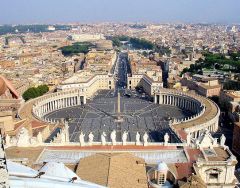
|
1) Name: Vatican Square 2) Artist: Gianlorenzo Bernini 3) Style: Baroque (Church Baroque) 4) Facts: a. Comissioned by Pope Paul V b. This is a very theatrical design, seems to almost pull people in with a “hug” (the circular construction, with narrowing ends) c. The 140 statues on top of the colonnade are of various saints |
|
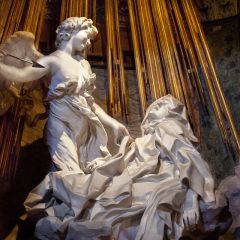
|
1) Name: The Ecstasy of St. Teresa 2) Artist: Gianlorenzo Bernini 3) Style: Baroque (Church Baroque) 4) Facts: a. Commissioned by Cornaro Family b. This is a very emotional piece, just looking at St. Teresa’s face you can see Bernini meant for this piece to display lots of sensualism. c. There is a diagonal which stretches from the top left to the bottom right, and a lot of gold (the pipes hanging from the ceiling in the back) that is seen in traditional baroque. |
|
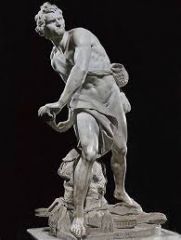
|
1) Name: David 2) Artist: Gianlorenzo Bernini 3) Style: Baroque (Church Baroque) 4) Facts: a. Commissioned by the Nephew of Pope Paul V b. This figure has a very strong diagonal, he is very committed to action with the non-frontal view which makes you have to interact with the whole image. c. When Bernini originally designed this figure he had planned for it to be nude. However, because modesty had become emphasized in this period he was required to cover the figure's private parts up. |
|
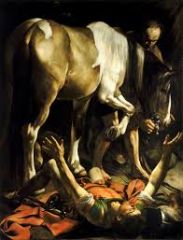
|
1) Name: Conversion of St. Paul 2) Artist: Caravaggio 3) Style: Baroque (church baroque) 4) Facts: a. The size of this painting is massive 90 1/2” by 68 7/8” helps to make the viewer feel as if they are actually inside the scene. Caravaggio also uses the way Saul is positioned to draw the viewer in. (known as foreshortening) b. The light in this painting is for symbolic purposes. It shows the “light of Christ” on Saul making him blind. c. The use of Tenebrism (invented by Caravaggio) is heavy in the painting. |
|
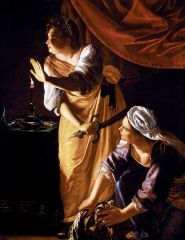
|
1) Name: Judith and Maidservant with head of Holofernes 2) Artist: Gentileschi 3) Style: Baroque (church baroque) 4) Facts: a. This painting for Gentileschi was sort of a self-portrait. She had been raped by her art teacher at 17, and in these paintings (she painted many of Judith and her maidservant) she identifies with Judith in a huge way. b. As with most baroque there is a diagonal where you can see the supposed movement. c. The light is "divine" in the fact that we cannot really see where it comes from. |
|
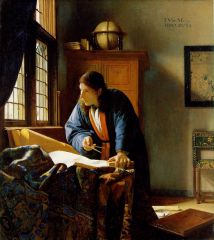
|
1) Name: The Geographer 2) Artist: Jan Vermeer 3) Style: Northern Baroque (secular baroque) 4) Facts: a. This painting is possibly modeled after Leeuwenhoek. b. Just like church baroque it has a diagonal, and a light source, however, you can see where it is coming from (the window, outside, the sun). c. This is a domestic interior painting. |
|
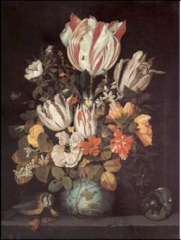
|
1) Name: Flowers in a Wan-li Vase with Blue Tit 2) Artist: Johannes Goedaert 3) Style: Northern Baroque (secular baroque) 4) Facts: a. This is a still life painting, which uses tenebrism. b. This is considered a Vanitas painting (symbolizes death or change, and that it is inevitable) demonstrated by the varying stages of tulip decay (everything will die), the fly, empty shell, and the bird eating moth (demonstrate the fleetingness of life) c. This could also be about Tulipmania, a huge rush to own and sell tulips in the Netherlands. Caused a huge stock market crash. |
|

|
1) Name: The Dancing Couple 2) Artist: Jan Steen 3) Style: Northern Baroque (secular baroque) 4) Facts: a. This scene has loads of moral symbolism in it. It shows a lot of the fleetingness of life and beauty, (the spilled flowers on the ground, broken eggshells) you can also see the loss of innocence (the baby’s lost shoe.) All of this is centered around the lady in the middle, telling her all of this stuff is fading quickly, so live life while you still can. b. This is a genre scene. c. The artist painted himself into this work of art. |
|
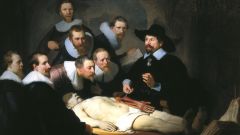
|
1) Name: The Anatomy Lesson of Dr. Tulp 2) Artist: Rembrant van Rijn 3) Style: Northern Baroque (secular baroque) 4) Facts: a. This is a historical painting. b. The light was used to highlight faces and the body of the dead to show how important these people were, specifically Dr. Tulp. You can see those actually interested in the lesson (the three leaning in towards the body) and those who are almost disgusted (the two on the left and the man in the back.) c. Foreshortening is used to draw the viewer into the painting (the book in the foreground). |
|
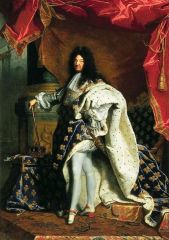
|
1) Name: Louis XIV, King of France 2) Artist: Hyacinthe Rigaud 3) Style: Royal Baroque 4) Facts: a. The royalty and patronage of the arts of the king are displayed through his dancing legs and high heels, as well as the fleur de lis and gold, which are shown to prove the richness of the king. b. You can clearly see the different textures of the materials (the felt cloak the king is wearing, etc.) c. The palace in Versailles is shown in the background (the columns behind the royal throne and canopy). |
|
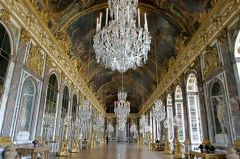
|
1) Name: Hall of Mirrors 2) Artist: N/A 3) Style: Royal Baroque 4) Facts: a. The ceiling includes 20 paintings of the government’s accomplishments. b. One wall in this hall is rows of windows, while the other has 357 mirrors to reflect the incoming light. c. While during King Louis XIV's reign this hall was mainly used as a passageway, it has been used for grand parties, weddings, and military agreements. |
|
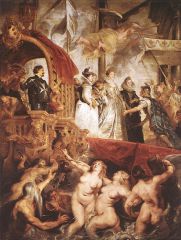
|
1) Name: The Arrival and Reception of Marie de Medici 2) Artist: Peter Paul Rubens 3) Style: Royal Baroque 4) Facts: a. This contains a lot of gold and a lot of motion, all to show what a highly famed lady has now entered the country. All of the people of France, the gods, water nymphs, and even the angel of fame have all come to greet this new queen of France. b. The water nymphs at the bottom of this painting are considered rubenesque figures because of their fleshly bodies. c. By looking at the sky and the water of this painting you can see the artist used very loose brushstrokes. |
|
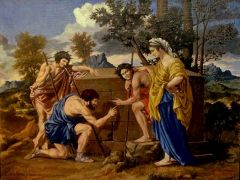
|
1) Name: The Shepherds of Arcadia 2) Artist: Poussin 3) Style: Royal Baroque 4) Facts: a. The tomb tells the shepherds that the dead man inside once stood where they are now (aka Momento Mori). b. This painting is more of an intellectual painting, you have to work to understand it. Shows the more reserved side of King Louis XIV. c. While this is considered royal baroque because it was painted during that period of time, it favors more of a renaissance style. |
|
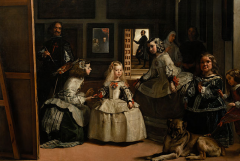
|
1) Name: Las Meninas 2) Artist: Diego Velasquez 3) Style: Royal Baroque 4) Facts: a. Velasquez draws the viewer in by placing the canvas at the front of the painting. You can tell he is hyper-aware of the viewer. b. The contrast of light-and-dark is used to highlight the key master, the king and queen in the mirror, and it hides the paintings of other famous artists in the background. c. This is a very complicated way or theme to paint a portrait, not only does Velasquez paint the children as he is supposed to, he also paints a self-portrait. |
|
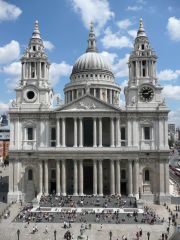
|
1) Name: St. Paul’s Cathedral, London 2) Artist: Christopher Wren 3) Style: English Baroque 4) Facts: a. The interior is based on the Latin Cross design. b. Many aspects of this design, such as the clocktower, sculptures, dome, columns, and the cross over the globe, are very similar to church baroque. c. The "Omen of St. Paul" is used as the keystone to the west hall |
|
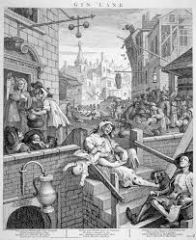
|
1) Name: Gin Lane 2) Artist: William Hogarth 3) Style: Enlightenment Satire 4) Facts: a. Done in such a way so that it could be easily distributed throughout the English people. b. Is meant to remind Londoners that there are still problems beyond what they might see. (everyone drinking themselves to death: starving, committing suicide, trading their lives away, and not taking care of their families.) c. The symbol above two buildings in this painting are the symbols for pawn shops that we still use today. |
|

|
1) Name: The Morning Party 2) Artist: William Hogarth 3) Style: Enlightenment Satire 4) Facts: a. You can see by many different aspects in this painting the unfaithfulness of the countess (the paintings on the wall, the statue of Actaeon, etc.) b. This is the fourth of a series of six paintings called Marriage à la Mode. c. This painting is currently housed in the National Gallery, London. |
|

|
1) Name: The Embarkation from Cythera 2) Artist: Jean-Antoine Watteau 3) Style: Rococo 4) Facts: a. This is a Fête Galante, which contains many items that show "love" like: Venus, Cupid, and the baby angels. b. Uses a lot of pastel colors, especially in the sky and on their clothing. c. Very asymmetrical, the movement goes from the right foreground to the left back. |
|
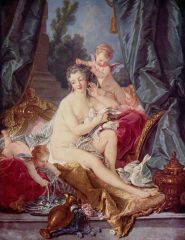
|
1) Name: The Toilet of Venus 2) Artist: François Boucher 3) Style: Rococo 4) Facts: a. Commissioned by Madame de Pompadour because she played the role of Venus in a play earlier in the same year. Her nude self is likened unto Venus in this painting. b. A very major use of soft pastel colors. c. Openly acknowledges the sexual role of Madame de Pompadour in the court. |
|
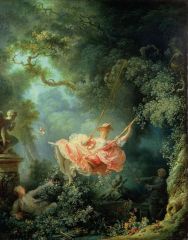
|
1) Name: The Swing 2) Artist: Jean-Honore Fragonard 3) Style: Rococo 4) Facts: a. Considered Rococo style because of the light pastels and the outside scene. b. The statue of cupid is letting us know that there is something secret going on here. There is a lover hiding in the bushes where her husband can't see. c. There is a loss of innocence shown by the loss of her shoe, and the white dog in the background is saying that the wife does not have faithful qualities, and the husband is literally left in the shadows. |

